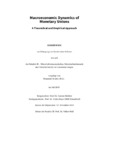Citation link:
http://dx.doi.org/10.25819/ubsi/729Files in This Item:
| File | Description | Size | Format | |
|---|---|---|---|---|
| Dissertation_Benjamin_Schaefer.pdf | 1.27 MB | Adobe PDF |  View/Open |
| Dokument Type: | Doctoral Thesis | metadata.dc.title: | Macroeconomic dynamics of monetary unions : a theoretical and empirical approach | Other Titles: | Makroökonomische Dynamiken in Währungsunionen : eine theoretische und empirische Betrachtung | Authors: | Schäfer, Benjamin | Institute: | Fakultät III - Wirtschaftswissenschaften, Wirtschaftsinformatik und Wirtschaftsrecht | Free keywords: | Macroeconomics, Monetary Unions, New Keynesian Economics, DSGE, Macroeconometrics | Dewey Decimal Classification: | 330 Wirtschaft | GHBS-Clases: | PQQ PNM |
Issue Date: | 2019 | Publish Date: | 2020 | Abstract: | Diese Arbeit betrachtet die „internen Abläufe“ von Währungsunionen aus der Perspektive von Asymmetrie, direkten Übertragungskanälen und mikroökonomischen Grundlagen, also wie die makroökonomischen Dynamiken von Preisen, Kosten und Produktion in einem Land diese Größen in anderen Ländern beeinflussen, gegeben dass diese Länder eine gemeinsame Währung und somit eine gemeinsame Geldpolitik haben. Das erste Kapitel gibt eine Einführung in das Problem wirtschaftlicher Verbundenheit in Währungsunionen, also wenn der nominale Zinssatz für alle Mitgliedsländer gleich ist und keine nominalen Wechselkurse zur Verfügung stehen, um idiosynkratische Schocks auszugleichen. Dieses Problem kann mit Hilfe der (neukeynes‘schen) Phillipskurve beschrieben werden. Kapitel 2 untersucht empirisch wie die gemeinsame Geldpolitik der EZB die Inflationsdynamiken in sechs Mitgliedsländern des Euro-Währungsgebietes beeinflusst. Schätzungen von Neuen Phillipskurven für diese Länder für drei Perioden der Stichprobe – Vorkrise, akute Krise und „Whatever-It-Takes“-Ära – zeigen den Einfluss der Krise und den der geldpolitischen Reaktion darauf auf die makroökonomischen Entwicklungen in Europa. Die Ergebnisse der Schätzungen variieren stark zwischen den einzelnen Ländern der Stichprobe und zeigen daher, dass es unangebracht ist, eine Währungsunion als einen großen, monolithischen Block zu betrachten anstatt als eine Gruppe von interagierenden Volkswirtschaften. Kapitel 3 entwickelt ein theoretisches, neukeynes‘sches Modell einer Währungsunion zweier Länder und erweitert die bekannte neukeynes‘sche Phillipskurve und die Dynamische IS-Kurve um weitere Terme, um die Übertragungseffekte aus dem anderen Land darzustellen. Eine Simulationsstudie zeigt dann die Reaktionen von Preis- und Produktionsdynamiken der beiden Länder auf verschiedene, gemeinsame oder idiosynkratische Schocks. Wie aus der Literatur bekannt sind idiosynkratische Schocks für eine Währungsunion schwieriger zu handhaben als gemeinsame Schocks. Allerdings könnte es weniger schwierig sein, als bisher angenommen, da die direkten Übertragungseffekte eine gewisse Prozyklikalität bewirken und damit die Übertragungsasymmetrien verringern. In Kapitel 4 wird das Modell nun anhand von Daten aus Europa – Deutschland und Frankreich – und den USA – Zensusregionen Nord-Ost und Süd – geschätzt. Das zentrale Ergebnis dabei ist, dass zumindest für Europa die üblichen Schätzgrößen für die Parameter des Modells reproduziert werden können, zusammen mit einer sehr plausiblen Schätzung für den Übertragungsparameter. Die Ergebnisse sind allerdings weniger überzeugend für die US-Zensusregionen und verstärken so den Eindruck dass die Natur der Europäische Währungsunion grundlegend verschieden von der US-Währungsunion ist. Diese Dissertation bietet einen theoretischen und empirischen Rahmen um Wirtschaftspolitik zu diskutieren und debattieren, wenn der Kontext eine Währungsunion wie in Europa ist, also eine Gruppe hochgradig vernetzter nationaler Volkswirtschaften mit einer Vielzahl nominaler Rigiditäten. This thesis looks into the "inner workings" of monetary unions, from the perspective of asymmetry, direct spillovers and microeconomic foundations, i.e. how the macroeconomic dynamics of prices, costs and production of one country influence these magnitudes in other countries, under the premise of sharing a currency and thus monetary policy. The first chapter gives an overview of the problem of economic interconnectedness in monetary unions, i.e. when nominal interest rates are the same for all members and nominal exchange rates are unavailable to smooth out idiosyncratic shocks. This problem can be operationalised using the (New Keynesian) Phillips Curve. Chapter 2 investigates empirically how the common monetary policy of the ECB influenced the inflation dynamics in six member countries of the Euro area. Estimating country-wise New Phillips curves for three periods, pre-crisis, crisis and "Whatever-It-Takes" we can pin down the effects of both the crisis and the ECB’s monetary policy response on the macroeconomic developments in Europe. The results from these estimations varied strongly across the countries in the sample, showing that it is inappropriate to treat an MU as a big monolithic bloc instead of a set of interacting economies. Chapter 3 develops theoretically a two-country, monetary union New-Keynesian Model, augmenting the familiar New-Keynesian Phillips Curve and the Dynamic IS Cuve with an additional term, the spillover from the other country. A simulation study then investigates how the price and production dynamics of the countries in such a union react to various common and idiosyncratic shocks. Like in the literature, for an MU idiosyncratic shocks are more difficult to deal with than common shocks, however may be not as difficult as previously thought, because the spillovers introduce a certain degree of pro-cyclicality thus reducing the transmission asymmetry. In chapter 4 this model is then estimated using data for Germany and France, and the US census regions North-East and South. The main finding is that, at least for Europe, the usual magnitudes of the parameters can be reproduced alongside a very plausible estimate for the measures of economic interconnectedness or the degree of spillovers. However, the model works less well for the US, suggesting that the European Monetary Union is fundamentally different from the US. This thesis provides a theoretical and empirical framework to discuss and debate economic policies in the context of a monetary union like in Europe, i.e. a set of highly interconnected economies with various nominal rigidities. |
DOI: | http://dx.doi.org/10.25819/ubsi/729 | URN: | urn:nbn:de:hbz:467-15558 | URI: | https://dspace.ub.uni-siegen.de/handle/ubsi/1555 |
| Appears in Collections: | Hochschulschriften |
This item is protected by original copyright |
Page view(s)
598
checked on Nov 25, 2024
Download(s)
263
checked on Nov 25, 2024
Google ScholarTM
Check
Altmetric
Items in DSpace are protected by copyright, with all rights reserved, unless otherwise indicated.

